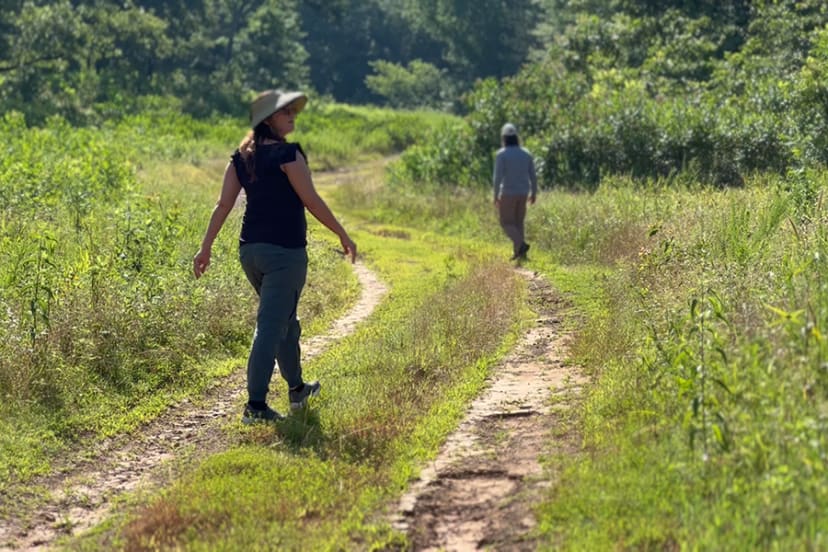This is a VNN Collaboration produced by VNN Oklahoma in partnership with Pursuit Films
Written By: Rachael Schuit and Brittany Harlow
Narrated By: Trista Vaughn
(CHEROKEE NATION) Genes are the code of life. A continuous pathway of one living being to another, carrying what has been into what will be.
Joe Ballard is a member of the Cherokee Nation.
A century after his ancestors were forced to march on the Trail of Tears from their ancestral homelands to what is now Oklahoma, the federal government kicked his grandfather off their family’s land again.
“The little that I do know from my dad, which they didn’t talk about it much, was they gave him 50 cents an acre and told him to get the hell out,” Joe said.
Joe’s family was one of 70 Cherokee families whose allotments were taken back when the U.S. Government established Camp Gruber in the 1940s.
Joe’s wife Grace is a licensed clinical social worker, somatic experiencing practitioner and the director and owner of Foundations Behavioral Health.
“The government came in and took their land on Camp Gruber, Cherokee Wildlife Refuge area, and burned their houses to the ground,” Grace said.
Grace has worked in the mental health field for 15 years, beginning as an alcohol and drug counselor in Claremore. She soon realized traditional methods weren’t getting through to her clients, 70 percent of which were Native American.
So Grace looked to her father-in-law Larry Ballard for guidance, who had also helped her get that counseling job to begin with.
“He helped me find the Red Road to Wellbriety,” Grace said. “And they just… It was incredible how much better they got and how much more quickly and they loved it. Bringing in culture and something that spoke to them and spoke to them in their roots, how quickly that helped them change and heal.”
Grace went on to seek out even more decolonized therapy practices, including somatic, or body-focused therapy, to help her clients heal from historic, shock, and complex traumas.
“Trauma is a loss of relationship,” she said. “It’s a loss of relationship with yourself and with other people. So you lose that relationship with yourself, and what we find with trauma is you’re actually losing relationship as well with your own body.”
She opened Foundations Behavioral Health in 2015 to help people heal from the trauma of a colonized society in nature-themed environments.
“I’ve heard some healers call it like, the spirit being scared away from the body, the shamanistic healers, and we have to bring the spirit back.”
“And a lot of times it is hard for people, because we rush around,” Grace said. “That’s the other reason why people are so disconnected from how much intergenerational trauma has affected them.”
Grace also draws inspiration from thought leaders such as Dr. Peter Levine, who teaches that to heal trauma, those broken connections must be restored.
During his time with the Hopi Tribe in Arizona, Levine learned trauma experienced there is shared pain, remedied as a community as opposed to centering on an individual. And if trauma is not dealt with quickly as a community, its consequences will negatively impact the tribe for seven generations. (Source: The power of connection to heal trauma | Kripalu)
“In the field of epigenetics, there’s research in mice where they take a mother that’s pregnant and they give her a shock with, let’s say, maybe a strawberry,” Grace said. “And then they measure the offspring with just the strawberry, not the shock, and they have the same reaction their mother did. And that typically happens for five generations, they found in the studies of epigenetics, but we’re a lot more complex than a mouse.”
Somatic therapy requires people to physically work through their trauma, retraining responses or even acting out the completion or a traumatic event.
“If there is not a completion of a response to a threat, this energy that the nervous system produces in the body has nowhere to go,” Grace said. “It just gets stuck. And can become what we kind of call a lay term, a holding pattern in the body.”
Holding patterns such as strong fight or flight responses that live on in those who have experienced relatively trauma-free lives. And other behaviors Joe has observed over the last two decades teaching at Tulsa Public Schools.
“As far as the Native kids, yeah, they’re not as talkative,” Joe said. “They’re not gonna give you as much stuff. And they’re really particular about their stuff too, which is kind of how I’ve always been. My stuff’s my stuff, stay out of my area. Don’t take my stuff. So it kinda makes sense a little bit to me.”
But along with the negative consequences of trauma are some positives.
“The past shapes our present and it shapes our future,” Grace said.
Grace said the strength and resilience of her Native American community members and her family are unlike any she’s ever seen.
Connecting pathways to improved health.
And completing long-awaited responses for healing.
This story is the first in the new VNN Oklahoma project “Tulsa’s Indigenous Truth”, supported with funding from the Data-Driven Reporting Project and the Commemoration Fund. The Data-Driven Reporting Project is funded by the Google News Initiative in partnership with Northwestern University | Medill. “Tulsa’s Indigenous Truth” addresses the underreported history of Allotment swindling and miscarriages of justice against Indigenous people in Eastern Oklahoma during the early 1900s. This story was created to demonstrate the deep connection between past injustice and contemporary issues. Donate here to support this much-needed work.

